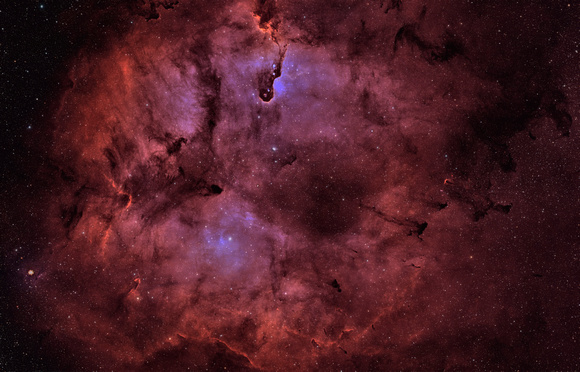IC 1396 -The "Elephant Trunk" Nebula/Cluster/Nursery in SHO w RGB stars (Cepheus) - May 2023
Teleview 1227is - AIS6200MM
A-P Mach2 GTO, Baader CMOS opt 6.5nm NB filters
H,O, S: (3 x 20 x 600s exposures, Bin 1x1, Gain 100)
R,G,B: (3 x 6 x 120s exposures, Bin 1x1, Gain 100)
Total Integration Time = 10.6 hours
Once stars have begun to form in the collapsing knots of a molecular cloud, they begin to blow away the rest of the surrounding material with solar winds and photon bombardment. Much of this momentum carrying is UV wavelength and we cannot see it. However, when this UV light impacts hydrogen and heavier elements, they glow mainly according to their characteristic spectra. This images was captured using filters that pass only the narrow wavelenghts associated with these spectra in addition to some thermal photons that happen to be of the right wavelength. Some of the few stars created near the central part of the cloud are visible, but it appears that this stellar nursary is just getting started.
Furthest away, in the ultra low density, barely disturbed cloud, the depest reds of Sulfur are seen. Glowing from red to green in this pallette is the additional hydrogen being pushed to the fringes of the cloud by the new stars. Heaviest elements, such as Oxygen, shown glowing blue (along with reflected light from the central stars), is the last to leave.
Remnants of the dark, dense molecular cloud knots also protect material behind it, forming fingers, columns, mountains and stringers behind them. The knots are being eroded by the stellar radiation, but are very slow to move.
One would think that this dispersive action would result in the end of star formation as the stars blow away material. Instead, the material gets further compressed by the "bulldozing" effect, while keeping the material behind the slowly moving front of the knot cold enough for additional star creation. Indeed new stars have been created within the "Elephant Trunk" structure at 12:00. These stars are now eroding the Elephant trunk from within.
At many of the tips of the knots, bright hydrogen emissions can be seen due to UV light colliding with front facing the stars. Otherwise the knots can be seen blocking most if not all of the light from the starfield behind it.
I used a new (at least for me) narrowband processing technique that uses the colour mapping equations shown
here and
here. I used GHS to generate the dynamic mapping weights by trial and error.


